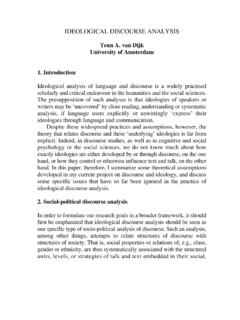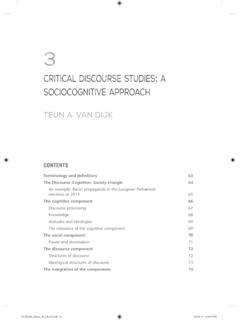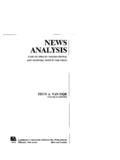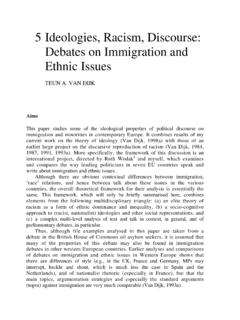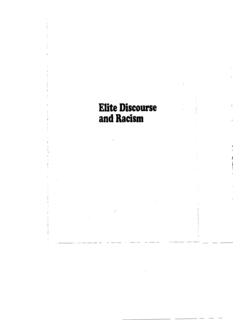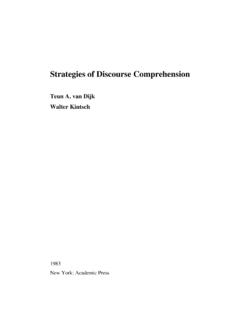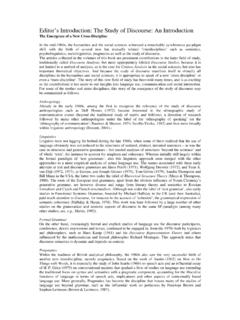Transcription of Analyzing Racism Through Discourse Analysis - …
1 6 Analyzing Racism Through Discourse Analysis Some Methodological Reflections teun a . VAN dijk This chapter draws some methodological conclusions from a research program on the reproduction of Racism Through Discourse and commu-nication. At the same time, it is my hope that these reflections allow other scholars engaged in the study of Racism to assess the theoretical and methodological relevance of Discourse Analysis for our understand-ing of ethnic and racial inequality. In a multidisciplinary research program on Discourse and Racism , carried out since 1980 at the University of Amsterdam, I have studied the ways majority group members write and talk about minorities, for example, in everyday conversations, textbooks, news reports, parlia-mentary debates, and academic and corporate Discourse . These analyses have focused on the following major questions, among others (for details, see van dijk , 1984, 1987a, 1987c, 1991): 1.
2 How exactly do members or institutions of dominant white groups talk and write about ethnic or racial minorities? 2. What do such structures and strategies of Discourse tell us about under lying ethnic or racial prejudices, ideologies, or other social cognitions about minorities? 3. What are the social, political, and cultural contexts and functions of such Discourse about minorities? In particular, what role does this Discourse Analyzing Racism Through Discourse Analysis 93play in the development, reinforcement, legitimation, and hence repro-duction of white group dominance? Although these questions focus on texts and their cognitive and sociocultural contexts, study of the issues raised requires a multidis-ciplinary approach that involves several disciplines in the humanities and the social sciences. One of the attractive roles of Discourse Analysis is that it is able to integrate such a multidisciplinary approach, also in the equally multidisciplinary study of ethnic or racial prejudice, dis-crimination, and Racism .
3 The major contribution of Discourse Analysis , however, takes place at the micro level of social practices involved in the enactment and reproduction of Racism . The Relevance of Discourse Analysis To spell out the broad multidisciplinary relevance of Discourse anal-ysis for our understanding of Racism , I will very briefly summarize some of the relations between Discourse and Racism in several disciplines of the humanities and social sciences. For the new discipline of Discourse studies itself, the study of the discursive reproduction of Racism Through text and talk provides not only a highly relevant field of application, but also more insight into the relations between various structures of text and talk on minorities on the one hand, and the mental, sociocultural, and political conditions, effects, or functionsthat is, various contexts of the reproduction of racismon the other hand.
4 Overlapping with its sister discipline of linguistics, the study of Racism and Discourse shows how various grammatical structures, to be discussed below, may express or signal the perspectives and ethnic biases of white group speakers. The study of history is largely based on the many types of discourses (stories, documents) from and about the past, including those about race and ethnic events and relations. A detailed Discourse Analysis of such historical texts allows us to make inferences about otherwise inaccessible attitudes and sociocultural contexts of Racism in the past. The social psychology of intergroup relations, and especially that of prejudice and ethnic stereotyping, focuses on, for example, the social cognitions, interpretations, and attribution processes of white dominant Analyzing Racism Through Discourse Analysis 94group members.
5 In both laboratory and field experiments and survey research, the data for this research are largely discursive: question-naires, experimental responses, think-aloud and recall protocols, stories or argumentation and accounts, among many others. Discourse Analysis allows us to make explicit the inferences about social cognitions of majority group members about minorities from the properties of their text and talk. Political science and the study of law are also largely based on Discourse , such as government deliberations in decision making, par-liamentary debates, laws, regulations, and so on, also with respect to ethnic affairs. Detailed study of these many forms of political Discourse reveals underlying sociopolitical and in particular ethnic attitudes of politicians, and the strategies of agenda setting and the manufacture of the ethnic consensus, among many other processes of the politics of ethnic affairs and immigration.
6 In sociology and anthropology (ethnography) Discourse Analysis plays a primary role in accounting for the structures of everyday interaction, for instance, in conversations in culturally variable sociocultural contexts. In both intercultural communication and talk and texts about ethnic minorities or non-Western peoples, thus, majority group speakers, or more generally people in the West, may engage in the local production and reproduction of white, Western group dominance, in communicat-ing stereotypes and more generally in the reproduction of social, cul-tural, or political hegemony. Such studies thus are not limited to the micro level of everyday interaction in sociocultural contexts, but also involve macro notions such as groups, social formations, or institutions, such as schools, business corporations, and especially the mass media.
7 Such processes involved in the reproduction of Racism are more specif-ically also studied in various subdomains of communication studies. We see that Discourse plays a central role not only in the text studies of the humanities, but also in the social sciences, and virtually all dimensions of the study of prejudice, discrimination, and Racism also have an important discursive dimension. This is primarily the case for all the basic data studied in these disciplines, namely, text and talk of white group members. Second, Discourse itself may be the object of research when it is seen to express, signal, confirm, describe, legiti-mate, or enact ethnic dominance, as in communication with or about ethnic minorities. This is true, third, both for the micro level of every-day interaction and for broader societal structures and processes involv- Analyzing Racism Through Discourse Analysis 95ing groups, group power and dominance, ideologies, and institutions.
8 One of the aims of this chapter is to urge social scientists engaged in the study of Racism to take (more) seriously the many Discourse data or discursive aspects of their object of study: Both theoretically and methodologically, they allow fine-grained and well-founded insights into the often subtle structures and processes of modern Racism . In sum, ethnic and racial inequality in all social, political, and cultural domains is multiply expressed, described, planned, legislated, regulated, executed, legitimated, and opposed in myriad genres of Discourse and communicative events. Such Discourse is not mere text and talk, and hence of marginal relevance. On the contrary, especially in contemporary information and communication societies, such text and talk are at the heart of the polity, society, and culture, and hence also in their mechanisms of continuity and reproduction, including those of Racism .
9 The Study of Discourse Not only in the humanities but also in the social sciences, this prominent role of Discourse is increasingly becoming recognized and subjected to systematic study-so much so, however, that confusion about the theories, goals, and methods of Discourse Analysis has become as widespread as their application in various disciplines. Indeed, the now often fashionable postmodern uses of the concept of Discourse have not always contributed to our understanding of the complex structures, strategies, mechanisms, or processes of text and talk in their sociocultural or political contexts. Therefore, we also need to summarize some of the backgrounds, goals, and approaches of what we see as the more explicit, critical, and relevant Discourse -analytic approach to Racism . Although Discourse studies historically go back to classical rhetoric, most contemporary approaches find their roots between 1965 and 1975, in the new structuralist or formalist approaches to myths, folktales, stories, and everyday conversations in anthropology, ethnography, sem-iotics, literary studies, and microsociology.
10 Much of this work was influenced by the sophisticated methods and concepts of linguistics, which itself also went beyond the self-imposed boundary of isolated sentences in order to explore the more complex grammatical and other structures of whole texts, and especially those of naturally occurring Analyzing Racism Through Discourse Analysis 96talk. Similar developments took place, as from the early 1970s, in the new cognitive psychological approaches to the mental processes of text comprehension. Other disciplines, such as social psychology and media and communication studies, followed suit in the 1980s, which also brought increasing multidisciplinary overlaps, influences, and integra-tion. Thus dialogic interaction or other texts in courtrooms, class-rooms, parliaments, or doctors offices, among many other contexts, came to be studied by sociolinguists, ethnographers, sociologists, com-munication scholars, psychologists, legal scholars, and political scien-tists alike (for an introduction to and survey of the different methods, fields, and applications of Discourse Analysis , see the contributions in van dijk , 1985b).

